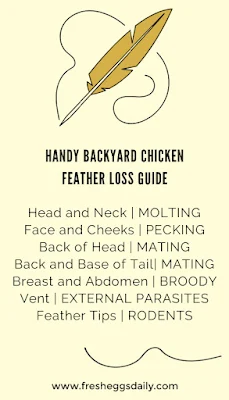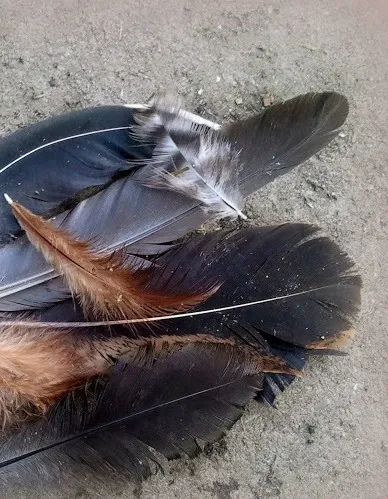Why are my Chickens Losing Their Feathers?
It seems that most of the time our run is littered with feathers. Sometimes it looks like a giant pillow fight went on.
Other times I literally do a headcount to be sure all our chickens and ducks are accounted for because it looks like a mass predator attack occurred.
But in reality, it is just a normal cycle of feather growth, loss and renewal.
Why are my Chickens Losing their Feathers?
There are several reasons why chickens lose feathers. The fall molt is the most common, but there are lots of other reasons why your chickens could be losing their feathers.
Regardless of the reason for a loss of feathers, increased protein is recommended, since feathers are predominantly comprised of protein.
But depending on WHY exactly your hen is losing her feathers, some other course of action might also be in order. So a bit of detective work helps to decide what exactly you're dealing with.
Here are some of the more common reasons chickens might lose their feathers and what course of action to take once you've determined the cause of the feather loss.
Preening
The ducks especially seem to shed lots of small soft feathers when they preen after getting out of their pool, but chickens preen also. This is just a natural hygiene routine.Preening is the process that birds use to distribute oils from the glands located at the base of their tails over their feathers and also to check for bugs and parasites.
The preen oil helps waterproof the feathers to some extent and also enables the hens to convert vitamin D from the sun into a form their bodies can use.
Preening is a year-round activity and perfectly natural.
The feathers lost from preening could be considered the equivalent of hair we lose when we brush our hair.
IndicationThere generally is no visible sign of feather loss from normal preening.
None.
Molting
A molt is fairly easy to identify by the pattern of feather loss.
A molt always starts at the head and moves down the neck and body to end at the tail.
Both sides of the hen will be fairly symmetrical as far as missing feathers.
Also, the new growth pushes out the old feathers, so there won't actually be bald spots - the new quills will already be protruding from the skin.
Course of Action
- Additional protein. Good sources of extra protein are meal worms, canned tuna or mackerel, scrambled eggs, chopped meat and other meat scraps, sunflower seeds.
- Try not to handle molting chickens any more than absolutely necessary. Growing in new feathers can be uncomfortable for them.
Broody Hen
A broody hen is a hen who decides she wants to hatch some eggs. She will stop laying and you will find her sitting in a nesting box 24/7.
Indication
The feather loss pattern on a broody hen is unmistakable.
Broodies pull out their breast feathers to provide a direct bond between the eggs they are sitting on and their skin.
Course of Action
- Discourage the broody if she isn't sitting on fertile eggs. [read how to 'break' a broody here]
- Also feed additional protein. Good sources of extra protein are meal worms, canned tuna or mackerel, scrambled eggs, chopped meat and other meat scraps, sunflower seeds.
Pecking
Feather pecking by other hens happens for several reasons: boredom, living in too close quarters or a protein deficiency. IndicationRandom feather loss with possibly bloody skin. Visibly seeing the pecking.
Course of Action
- Separate the bully if you can identify her. A couple of days apart should knock her down a bit on the pecking order.
- Be sure your run is large enough for the number of hens you have.
- Ten square feet per hen is the MINIMUM you should allow, but larger is always better.
- Provide your hens with things to amuse them: logs to stand on, branches in the run to perch on, a hanging basket filled with greens, a hanging treat feeder, plastic berry boxes filled with cracked corn or sunflower seeds, etc.
Parasites
Generally, if you can take some preventative measures, external parasites should not be a problem. Adequate dust bath areas, garlic in the daily feed and ffood-grade diatomaceous earth in the coop and nesting boxes should prevent parasites for the most part.
IndicationMissing feathers around the vent, bare skin. Visible identification of lice or mites.
Course of Action- Soak the hen in a tub of warm water, salt, Dawn dish detergent and vinegar.
- The lice should float to the surface.
- Dust the hen with food-grade diatomaceous earth.
- Repeat several days in a row until the parasites are gone.
- Increase protein to aid in feather regrowth.
Rodents
Mice and rats have been known to enter coops while chickens are sleeping and chew on their feathers for the protein or actually pluck feathers out to use as nest bedding.
Indication
Feathers missing the ends. Feathers with jagged edges and cuts taken out of them.
Course of Action- Make sure your coop door is locked each night and check corners of the coop and nesting boxes for existing rodents.
- Cover any openings in the coop with 1/2" hardware cloth to prevent rodents from gaining access.
- Planting mint around the coop or sprinkling fresh or dried mint in the coop can also deter rodents.
Roosters
When they mount a hen to mate, they dig their feet into the hen's back and grab the back of her head with their beak for balance.
Bare spots on the back of the head and back, could also be blood and raw skin.
- Be sure your hen/rooster ratio is 10-12 hens per rooster to ensure that no one hen is getting too much 'attention'.
- Separate the rooster in extreme cases.
- Hen saddles can also help both to prevent further injury and to protect the area while the feathers grow back.
Any sign of feather loss on a hen should be immediate cause for further investigation, but not necessarily concern.
Much of the loss is perfectly natural and beneficial.
In any case, additional protein is the recommended course of action to help regrow new, healthy feathers, but just a bit of further investigation can help you get to the root cause of the feather loss to better treat, or possibly prevent it.






































